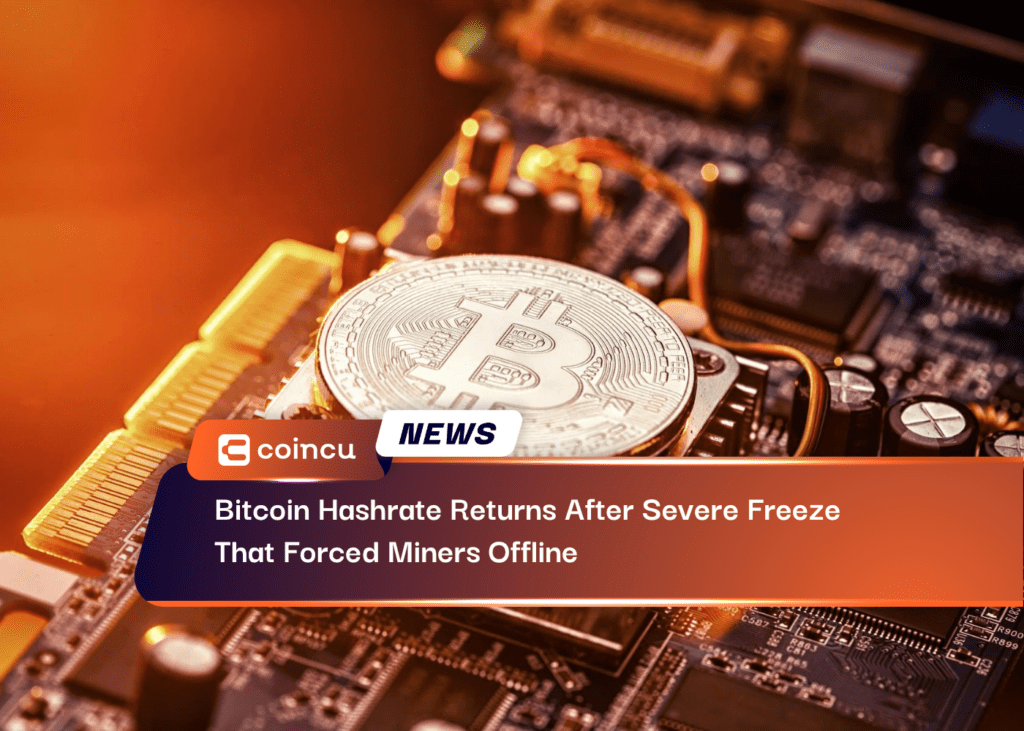Days after frigid conditions across the US burdened the country’s energy grid, causing a short reduction in hashrate, the Bitcoin network hashrate has once more reached normal levels.

Bone-chilling temperatures that gripped the country in the days before Christmas left millions of people without electricity and claimed at least 28 lives.
According to reports, Texas-based bitcoin miners, who contribute significantly to the hashrate of the nation, voluntarily scaled back their operations to return power to the grid so that locals may continue to heat their homes.
Bitcoin’s hashrate, which generally ranges between 225 and 300 Exahashes per second (EH/s), appears to have been affected by the outages. On Dec. 25, this decreased to 170.60 EH/s.
However, as of December 26, the hash rate was back at 241.29 EH/s, according to information from the hash rate mining calculator CoinWarz.
The quantity of hashes generated by Bitcoin miners as they attempt to solve the following block is used to determine the currency’s hash rate. It is a crucial indicator of how safe the Bitcoin network is.
John Stefanop, the founder of FutureBit, made a contentious statement in response to the current events, suggesting that the decline in hash rate was caused by several “highly concentrated miners” in Texas shutting down simultaneously.
“I know, does not change the fact that a few large mines in Texas affect the entire network to the tune of 33%…everyones transactions are now being confirmed 30% slower because the hashrate is not decentralized enough,” he said.
“If hashrate was distributed evenly around the world by 10’s of millions of small miners instead of a few dozen massive mines, this event would not have even registered on the network,” Stefanop added.
Dan Held, a bitcoin proponent, disagreed with Stefanop’s interpretation of the events, claiming that weather patterns do not indicate centralized ownership or control.
The Cambridge Bitcoin Electricity Consumption Index estimates that the United States accounts for 37.84% of the world’s monthly average hash rate share. New York, Kentucky, Georgia, and Texas are the top four states in the nation for mining bitcoins; all four had power disruptions due to the winter storm.
Although the bad weather, notably in Texas, forced 30% of Bitcoin’s hash power in the United States to go offline, the network “continues to perform brilliantly,” Satoshi Action Fund CEO Dennis Porter said to his 127,400 Twitter followers on December 25.
Texas has experienced recent growth in Bitcoin mining due to affordable power and kind mining regulations and is now home to some of the biggest mining operations in the world.
Core Scientific, Riot Blockchain, Argo, Bitdeer, Compute North, Genesis Digital Assets, and Argo, all of whom just got a $37.4 million bankruptcy loan to keep afloat.
Bitcoin mining companies have only increased due to current weather conditions
According to current research, the bear market has caused $4 billion in debt for Bitcoin mining companies.
In recent months, other well-known mining companies with headquarters in the United States have also declared bankruptcy. Many more businesses are on the verge of achieving debt-to-equity ratios that are almost unmanageable and necessitate quick restructuring.
The unfortunate weather-related incidents have not yet impacted the price of bitcoin, which is presently trading at $16,826 and has only decreased by 0.27 over the past 24 hours.
DISCLAIMER: The Information on this website is provided as general market commentary and does not constitute investment advice. We encourage you to do your own research before investing.
Join us to keep track of news: https://linktr.ee/coincu
Website: coincu.com
Annie
Coincu News





